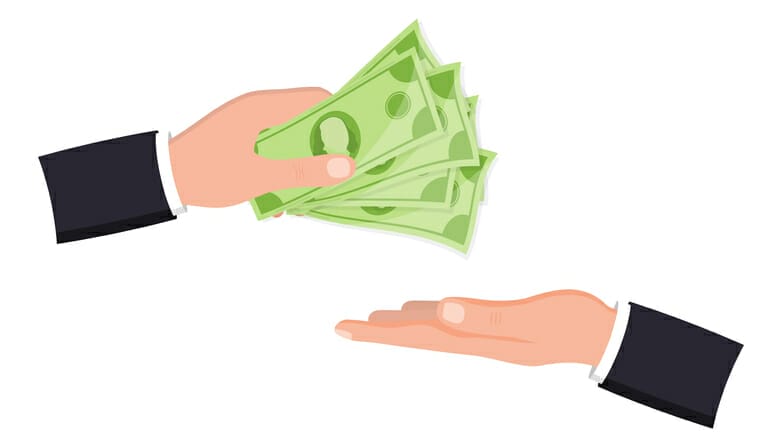My philosophy about MSP marketing is, and always has been, that if I spend a dollar on marketing today, I should be able to directly point to a sale and tangible ROI from that investment as quickly and efficiently as possible. In my world, we don’t count hashtags, likes, friends, and followers as “success.” Only dollars generated in sales from new customers count, and every dollar you spend should directly support the goal of driving profitable customers in the door and additional revenue from existing clients.
However, the simple reality is that marketing CAN’T always get that job done on its own. At some point, a SALESPERSON needs to answer the call, book the appointment, conduct the demo or consultation, and ultimately, close the sale. Thinking that a great marketing plan will instantly produce more sales is asking it to do too much — a bridge too far.
In many cases, marketing is blamed for the failings of the sales team. “The leads were weak” is a very common complaint of crybaby sales reps who ONLY want leads who are “buyers in heat,” showing up with a check in hand and unbridled enthusiasm about buying TODAY.
And while marketing can certainly produce some leads that fit that criterion, it significantly limits the number of opportunities you’ll get, filtering out anyone who has a question, concern, or desire to talk to someone first before they buy. Candidly, if my marketing could produce those kinds of leads, I wouldn’t have a need for professional salespeople. I could hire administrative assistants to simply process the orders.
So, what CAN marketing do, and where are its limits? Here’s a short list of what you can and should expect from your marketing efforts.
Replace COLD Prospecting
Great marketing can drive inbound leads of people who have a serious interest in buying or are at least open to the idea of a conversation. Even with all the available marketing media and strategies today, some companies still stupidly rely on salespeople to sift, sort, and trudge through an ice-cold list of names in search of a gold needle in a haystack.
This is the fastest way to lose a great sales professional through burnout. Salespeople don’t get burned out from selling — they get burned out, tired, and frustrated from prospecting. When you finally get a marketing plan producing AND you’ve built a great list of unconverted leads in the process of getting ready to buy, selling gets a lot more productive and easier because you let your marketing systems find, qualify, and cultivate buyers.
Make A Good Salesperson GREAT
Following on the previous, a good salesperson should spend the majority of their time talking to prospects who have some level of willingness and ability to buy what you’re selling. Really great marketing can presell and predispose a prospect to want to do business with your organization by answering frequently asked questions, building trust, demonstrating differential value and USP (unique selling proposition), and creating urgency to buy.
Great marketing can provide client testimonials and case studies to demonstrate competence, introduce risk-reducing guarantees and proof, reduce or eliminate fee resistance, and EDUCATE the prospect on what “good” is and what to look for when buying what you’re selling, which makes you the OBVIOUS choice regardless of price. All of this makes the actual process of selling EASIER.

Recently, I hired a top salesperson from a very well-known and well-run organization local to Franklin, where we have our offices. I was delighted to actually recruit their rock star and had great expectations for his performance.
However, it quickly became apparent that he didn’t know how to sell at ALL. I was actually shocked at how abysmal he was in his ability to have a consultative conversation, ask good questions, and LISTEN. As you might imagine, he didn’t last long. So, what went wrong? To my estimation, the company he previously worked for was so well-known and great at marketing that he only had to take orders, not sell — and when he came to our team, we grilled him on good sales processes, which he was unable to grasp, so I never felt comfortable putting him on the phone with a prospect of ours.
This is a very common scenario to be aware of when hiring salespeople. Many can be great IF sufficient marketing props them up. If you don’t have strong name recognition and a powerful brand to support the sales effort, someone who was a rock star in another organization that has those marketing assets may turn out to be a terrible rep for you. Of course, if you build that level of marketing power, you have the advantage of hiring average people and getting them to perform brilliantly.
Repel Wrong-Fit Prospects
Most businesses don’t give much thought to who they DON’T want as a customer, often because they’re starved for business to the point where they’ll take almost anyone. Big mistake. If your target market is “anyone,” you don’t have a target market — and part of communicating who IS a right fit is communicating who the wrong fit is.
In my business, I make it abundantly clear that we aren’t selling instant rice. Success in marketing requires a commitment to doing the work and sticking with a strategy long enough to get it to work. That is the extreme opposite of what many other marketing “gurus” will tell you. They’re selling easy buttons and quick fixes because those have universal appeal.
Who doesn’t want a four-hour workweek or seven-minute abs? It’s hard to sell “homework” that will produce results over time. However, I know our best client isn’t one created with quick fixes and shortcuts. They want a REAL business and marketing plan that will actually sustain them and deliver consistent success, not a Happy Meal with a cheap prize in the box.
To see an example of a letter I recently wrote to MSPs considering doing business with us, designed to not only attract “right fit” prospects to us but also REPEL the ones we don’t want, go online to MSPSuccessMagazine.com/letter.
Help A Not-Quite-Ready-To-Buy Prospect To Mature
Obviously, not all leads and prospects that show interest will be ready to buy immediately following your initial interaction. Some are just starting the process of buying. Others may have had their interest piqued and, with good marketing, can be developed into a buyer. Good marketing can keep you top of mind and continually develop lukewarm leads into “buyers in heat” without the need for a human being to interact.
This can be done with email, direct mail, and social media posts. Of course, a salesperson could get involved and reach out by phone or email to send a prospect the latest report you’ve published or invite them to a webinar — all acts of drip marketing to keep that prospect engaged.
This ongoing drip marketing of interesting content is not what most companies do. If you’ve ever shown interest in a service — be it online, at a trade show, or in some other context — you know the most you’ll get are a flurry of emails, calls, and possibly texts for a period of about a week. After that, they give up, never to be heard from again. This is incredibly stupid and wasteful. Nearly 51% of our leads convert after six months of follow-up. If I failed to continue to market to them, my company would be a fraction of the size it is today.
Desensitize Prospects To (High) Price
When you visit a Rolex dealer or a Rolls-Royce showroom, you never expect to see balloons, a hot dog stand, and a clown waving a neon-yellow sign promoting a “BIG SALE today!” That’s because their positioning and marketing have set the expectation of expensive luxury. It’s WHY people buy a Rolex or a $450,000 Rolls-Royce. They are buying status and prestige, not a way to tell time or a car to get around in.
That’s not to say you need to take the same position (although it certainly could be a position to take). It is to say that your marketing, which is everything a prospect sees and experiences prior to making a sale, can set the stage for them to expect quality, not cheapness.

Many MSPs have the erroneous belief that everyone buys IT on price when it’s simply not true. Price is certainly one key component of the decision-making process, but only a very tiny percentage of prospects base their decision solely on price. They’re looking at any number of factors, including how professionally you behave, the materials you present them with about who you are and what type of clients you work with, your areas of expertise and competence, reviews and references, the diagnostic process and questions you ask (or FAIL to perform and ask), how you present the solution, and how much they trust you can actually do the job well and to their expectations. The ghosts of bad vendors’ “promises past” haunt them, and they are fearful of making (yet again) another mistake.
One of the ways you can use marketing to desensitize prospects to price is through the use of a good Shock-And-Awe box, which is a box or folder of materials you send to a qualified prospect in advance of the meeting. Inside should be a number of trust- and credibility-building marketing assets (reports, books, comparison charts, client testimonials, guarantees, etc.) that demonstrate why a prospect would do business with you. You want to convey in multiple ways that you are NOT the cheapest but the highest value and right for only a select group of clients. My clients have shared their close-rate increases by 20% or more simply by using this one tactic.
So, was your recent sales failure a MARKETING failure or a SALES misstep? Was the list bad? The campaign poorly written? Or was it the bad experience they had when calling your office or attempting to book the appointment? Maybe a little of all these.
But the only way to solve it is to make sure you knit together your marketing AND sales into a seamless, consistent, and well-designed SYSTEM so every prospect has the ideal experience every time, from the moment they click on your ad to when they sit with you on the initial appointment. ONE mistake in the process can throw a prospect off the trail, leaving you with a no-close outcome.
If you’re an owner of an MSP or IT services business, who wants a proven blueprint to get more high-value and appreciative clients WITHOUT discounting or doing all the quoting, closing and prospecting work yourself, you MUST attend our 2-day MSP Sales Roadshow. Click below for a special offer and to register.












